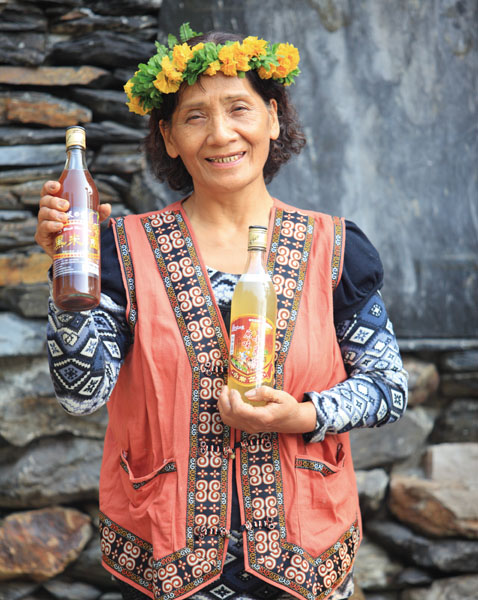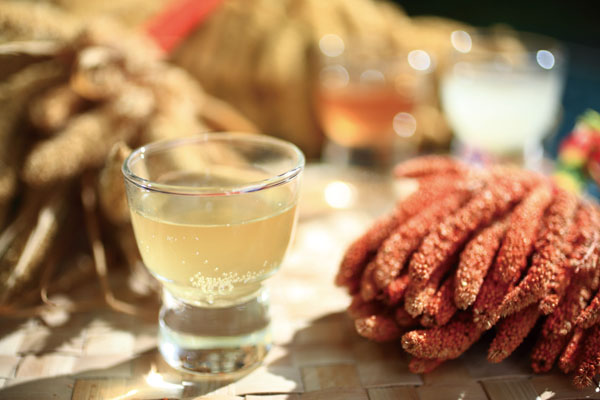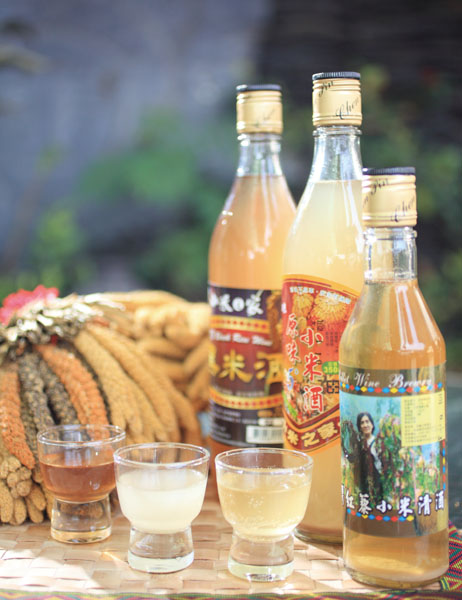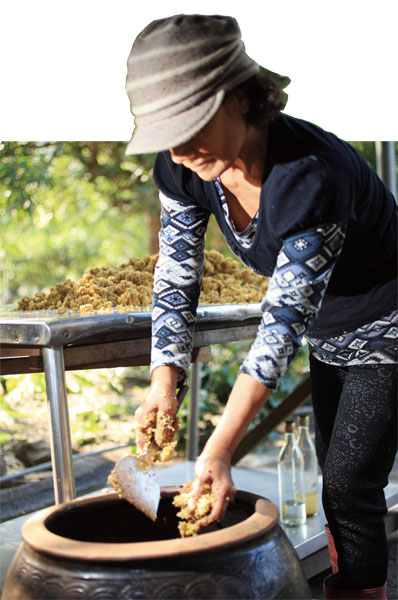A Good Drink Worth the Trip – Ms. Ceng Chan Yu-cin's Millet Wine/茂林部落飄來的酒香 曾詹玉琴的小米酒
 A Good Drink Worth the Trip – Ms. Ceng Chan Yu-cin's Millet Wine
A Good Drink Worth the Trip – Ms. Ceng Chan Yu-cin's Millet Wine
◎English Translation by Peng Hsin-yi ◎Photos by Lin Yu-en
As indigenous culture makes a comeback, many wonderful aboriginal traditions are getting a new lease on life. One of the most celebrated is the making of millet wine, and in Kaohsiung City's Maolin District, the connoisseur of millet wine is no other than Ms. Ceng Chan Yu-cin, a resident of Maolin Village (called Teldreka in the language of the area's Rukai aborigines).
Thanks to word of mouth, the fame of her brew has reached as far as north China's Heilongjiang province. Indeed, a proposal for collaboration has been extended to her by a liquor company in that province, because they want to work with someone who makes wine by following time-tested recipes and does not cut corners in any way. Ms. Ceng Chan is such a person.
 Like many of her fellow aborigines, Ms. Ceng Chan left home at a young age and moved to the big city. She achieved the kind of success she sought, but eventually felt burned out. At the end of the day, she realized, all she wanted was to sit under a tree and chat into the night with friends and family. So she gave up city life and went home. But something was missing. She remembered that millet wine was frequently shared on social occasions, but to her astonishment she could not find it anywhere. Somehow, the art of making millet wine – previously a skill passed down from mother to daughter – was close to slipping into oblivion. As a daughter of the tribe, she was determined to rectify that.
Like many of her fellow aborigines, Ms. Ceng Chan left home at a young age and moved to the big city. She achieved the kind of success she sought, but eventually felt burned out. At the end of the day, she realized, all she wanted was to sit under a tree and chat into the night with friends and family. So she gave up city life and went home. But something was missing. She remembered that millet wine was frequently shared on social occasions, but to her astonishment she could not find it anywhere. Somehow, the art of making millet wine – previously a skill passed down from mother to daughter – was close to slipping into oblivion. As a daughter of the tribe, she was determined to rectify that.
 Like many women of her generation, Ms. Ceng Chan did not pay attention to tribal traditions when she was younger, so she had no idea how to make millet wine. However, she became a woman with a mission. She began by making experimental batches, and tried to pick up tips and tricks through casual chats with elders. After she finally discovered that the secret to making the millet wine is to use raw Chenopodium formosanum (a kind of goosefoot commonly known as Taiwanese quinoa), she successfully revived the tradition of making millet wine.
Like many women of her generation, Ms. Ceng Chan did not pay attention to tribal traditions when she was younger, so she had no idea how to make millet wine. However, she became a woman with a mission. She began by making experimental batches, and tried to pick up tips and tricks through casual chats with elders. After she finally discovered that the secret to making the millet wine is to use raw Chenopodium formosanum (a kind of goosefoot commonly known as Taiwanese quinoa), she successfully revived the tradition of making millet wine.
In the old days everyone made millet wine, so the task looked deceptively simple. However, many factors need to be taken into consideration. For example, it is best to start on a sunny day because high humidity increases the chance of mold growth during fermentation. The millet must be boiled on a wood-burning stove, and Ms. Ceng Chan insists on using substantial pieces of wood rather than twigs to ensure a delicious consistency that cannot be reproduced on a gas stove. Next, she mixes the cooked millet and raw unhusked Taiwanese quinoa into a fine mash. It is left to sit for three or four hours so the natural yeast can do its work. When the mash has reached the desired stage of fermentation, she puts it in ceramic jars, covers it with pure mountain-spring water and seals the jars. This mixture is allowed to sit for a week or so and then opened again so mountain-spring water can be stirred in (at a temperature of about 25 to 30 degrees Celsius, 77 to 86 degrees Fahrenheit) before it is sealed and left to mature. When the jar is opened a month later, a warm fragrance of millet wine floods the entire room. The flavor of the wine is clean yet complex, with a velvety texture that goes down smoothly. Thanks to her dogged determination, Ms. Ceng Chan has successfully preserved the drink's true, traditional taste.
 Ms. Ceng Chan says good millet wine is light yellow in color but should be crystal clear. Give the bottle a gentle swirl, and you should see a fine string of bubbles rising from the bottom to the top. That proves the wine is "alive," she says. Ms. Ceng Chan explains that the fragrance and taste of her wine improves as it ages. Her beverage, like her personality, goes straight to your heart with an irrefutable stream of warmth.
Ms. Ceng Chan says good millet wine is light yellow in color but should be crystal clear. Give the bottle a gentle swirl, and you should see a fine string of bubbles rising from the bottom to the top. That proves the wine is "alive," she says. Ms. Ceng Chan explains that the fragrance and taste of her wine improves as it ages. Her beverage, like her personality, goes straight to your heart with an irrefutable stream of warmth.
 茂林部落飄來的酒香 曾詹玉琴的小米酒
茂林部落飄來的酒香 曾詹玉琴的小米酒
◎文/侯雅婷 ◎攝影/林育恩
曾詹玉琴是茂林地區魯凱族釀製原住民小米酒的第一把交椅,她釀製的小米酒遠近馳名,質樸而純熟的製酒手藝,讓中國黑龍江酒廠都上門談合作,對方表示,就是想找像她這樣實實在在地以小米製酒的特色酒莊。
跟很多人一樣,曾詹玉琴年輕時就到外地打拼,事業順遂卻身心俱疲,倦鳥歸巢只為了能與家人、朋友坐在樹下談天說地。返鄉後,遍尋不著記憶中,小米酒的味道,曾幾何時部落婦女必備的釀酒手藝面臨更迭失傳的窘境,那時的她雖然不懂釀製,彷彿有種使命,下定決心要釀製出「正宗小米酒」,經過一次次的試驗,每次與部落耆老閒談,她總豎起耳朵,聚精會神地學功夫,才恍然大悟,原來關鍵在得使用生的紅蔾,終於讓她找到成功釀製小米酒的方法!
看似簡單的小米酒製程隱藏了許多細節,製作時得是晴朗的日子,天氣如果不好,釀製的酒容易發霉,從燒柴蒸煮小米就不能馬虎,得選用實心的木頭,這樣煮出的小米會特別好吃,接著全把連殼搗碎的生紅藜與小米拌在一起,等待3至4小時,讓小米慢慢發酵,接著放進甕裏,加上山泉水,蓋起來等待一個星期後再加進25至30度微溫的山泉水,再密封約一個月就大功告成。打開瓶蓋,米釀的溫潤酒香在空氣中流轉瀰漫,啜飲清冽的小米酒,層次豐富的酒香帶著小米的香氣,溫潤順口。不禁讓人慶興,還好曾詹玉琴有種不放棄的傻勁,因而保留了小米酒的好味道。
曾詹玉琴說,好的小米酒呈現清澈的淡黃色,搖酒瓶時,細小的氣泡從底部冒起來,這就是她口中活的小米酒且越陳越香。曾詹玉琴的小米酒和她的人一樣,打動人心的永遠是那一股溫暖的感覺。